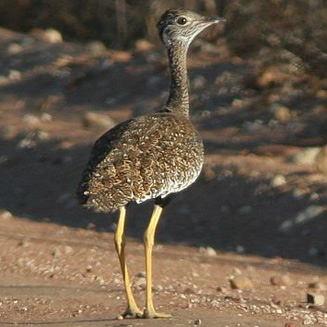|
Afrotis afra (Southern black
korhaan)
[= Eupodotis afra]
Swartvlerkkorhaan [Afrikaans]; Ikhalu-khalu [Xhosa]; Epampa
(generic term for korhaan) [Kwangali]; Lekakarane [South Sotho]; Motlatlawę,
Tlatlagwę [Tswana]; Zwarte trap [Dutch]; Outarde korhaan [French]; Gackeltrappe
[German]; Abetarda-d'asa-preta [Portuguese]
Life
> Eukaryotes >
Opisthokonta
> Metazoa (animals) >
Bilateria >
Deuterostomia > Chordata >
Craniata > Vertebrata (vertebrates) > Gnathostomata (jawed
vertebrates) > Teleostomi (teleost fish) > Osteichthyes (bony fish) > Class:
Sarcopterygii (lobe-finned
fish) > Stegocephalia (terrestrial
vertebrates) > Tetrapoda
(four-legged vertebrates) > Reptiliomorpha > Amniota >
Reptilia (reptiles) >
Romeriida > Diapsida > Archosauromorpha > Archosauria >
Dinosauria
(dinosaurs) > Saurischia > Theropoda (bipedal predatory dinosaurs) >
Coelurosauria > Maniraptora > Aves
(birds) >
Order: Gruiformes
> Family: Otitidae
 |
 |
|
Southern black korhaan male, Velddrif, South
Africa. [photo Trevor Hardaker ©] |
Southern black korhaan female, Heerenlogenment,
South Africa. [photo Trevor Hardaker ©] |
The Southern black korhaan is endemic to South Africa,
being found in the Western, Eastern and Northern Capes. It is common to uncommon
in the remnants of renosterveld and strandveld in the Western Cape, and nama
karoo in the Northern Cape. It feeds on insects, small reptiles and plant
material, foraging on the ground and picking up food items with its bill. It is
polygynous, meaning that the male mates with multiple females, who do all the
incubation and caring of the chicks. Its 1-2 are laid eggs directly on the
ground, often so that it conceals the incubating female.
Distribution and habitat
Endemic to South Africa, occurring in the Western Cape,
marginally extending into the Eastern and Northern Cape. It is common to
uncommon in the remnants of renosterveld, as well as strandveld and Nama karoo.
Food
It eats mainly insects, small reptiles
and plant material, foraging on the ground and picking up food items with its
bill. The following food items have been recorded in its diet:
Breeding
- Polygynous, meaning that one male mates with
multiple females.
- It does not use a nest, instead laying its eggs directly on the ground,
typically in an area that conceals the incubating female.
- Egg-laying season is from August-January, peaking from
September-October.
- It lays one, rarely two eggs, which are incubated solely by the female.
- The chicks are are cared for by the female only.
Threats
Not threatened, although it probably suffered major habitat
loss due to the cultivation of the Western Cape lowlands.
References
-
Hockey PAR, Dean WRJ and Ryan PG (eds) 2005. Roberts
- Birds of southern Africa, VIIth ed. The Trustees of the John Voelcker
Bird Book Fund, Cape Town.
|
